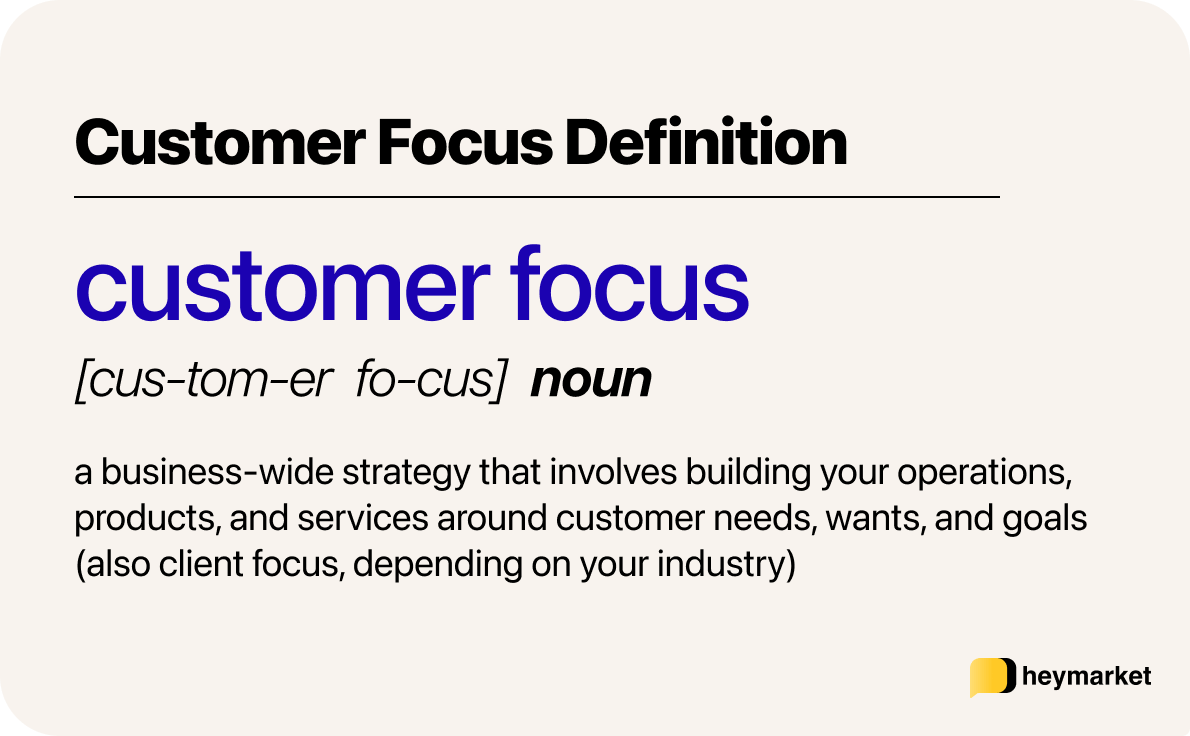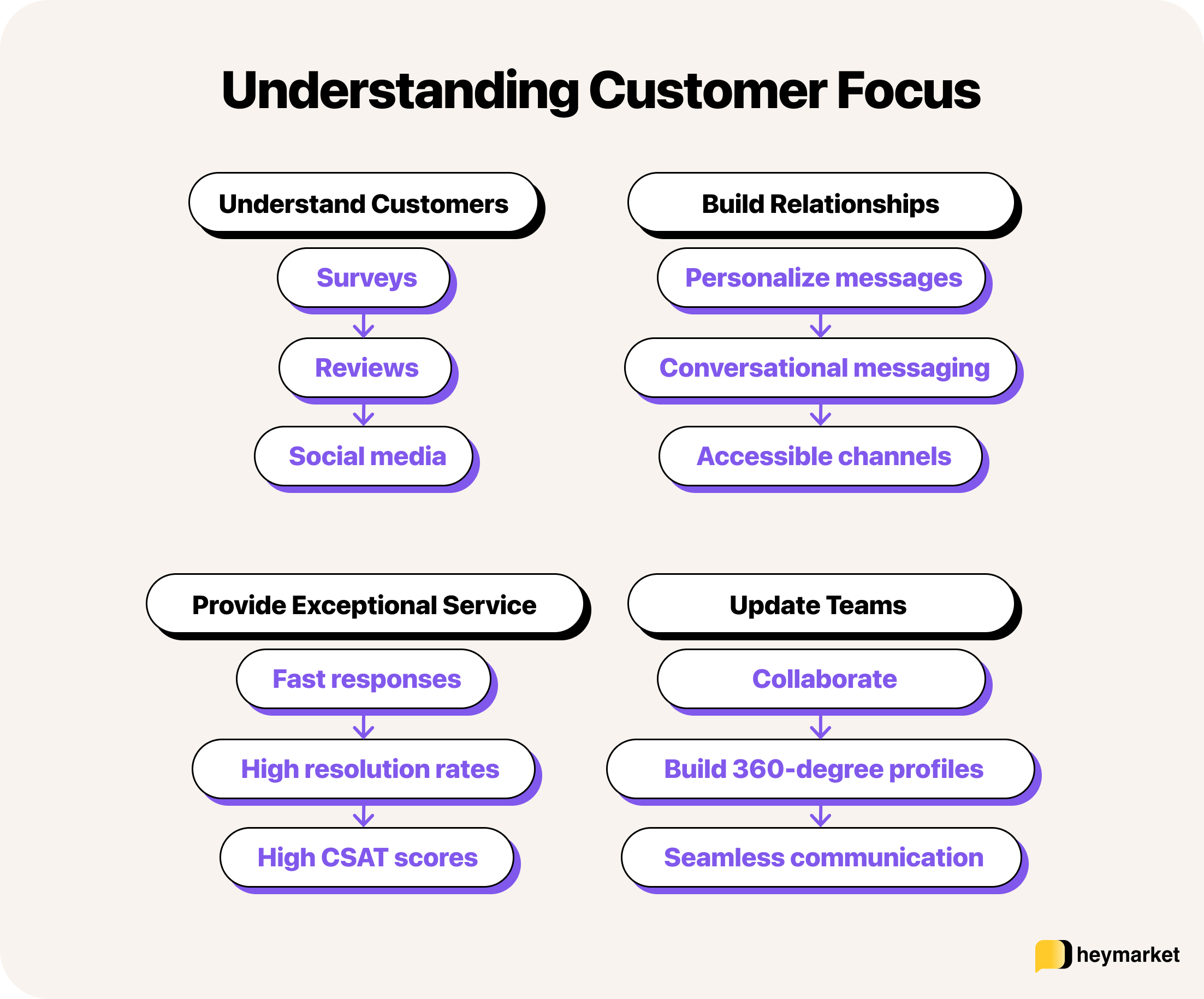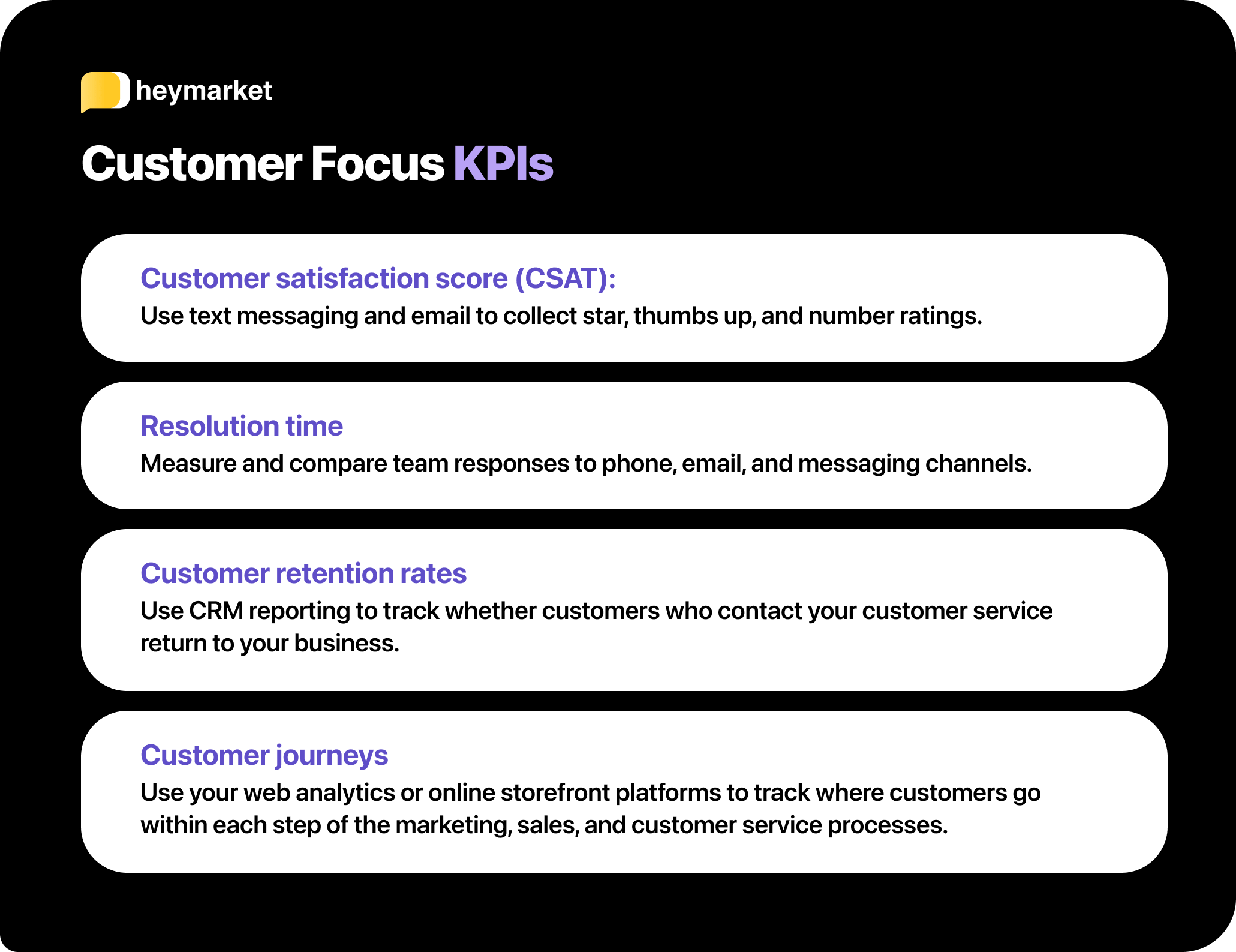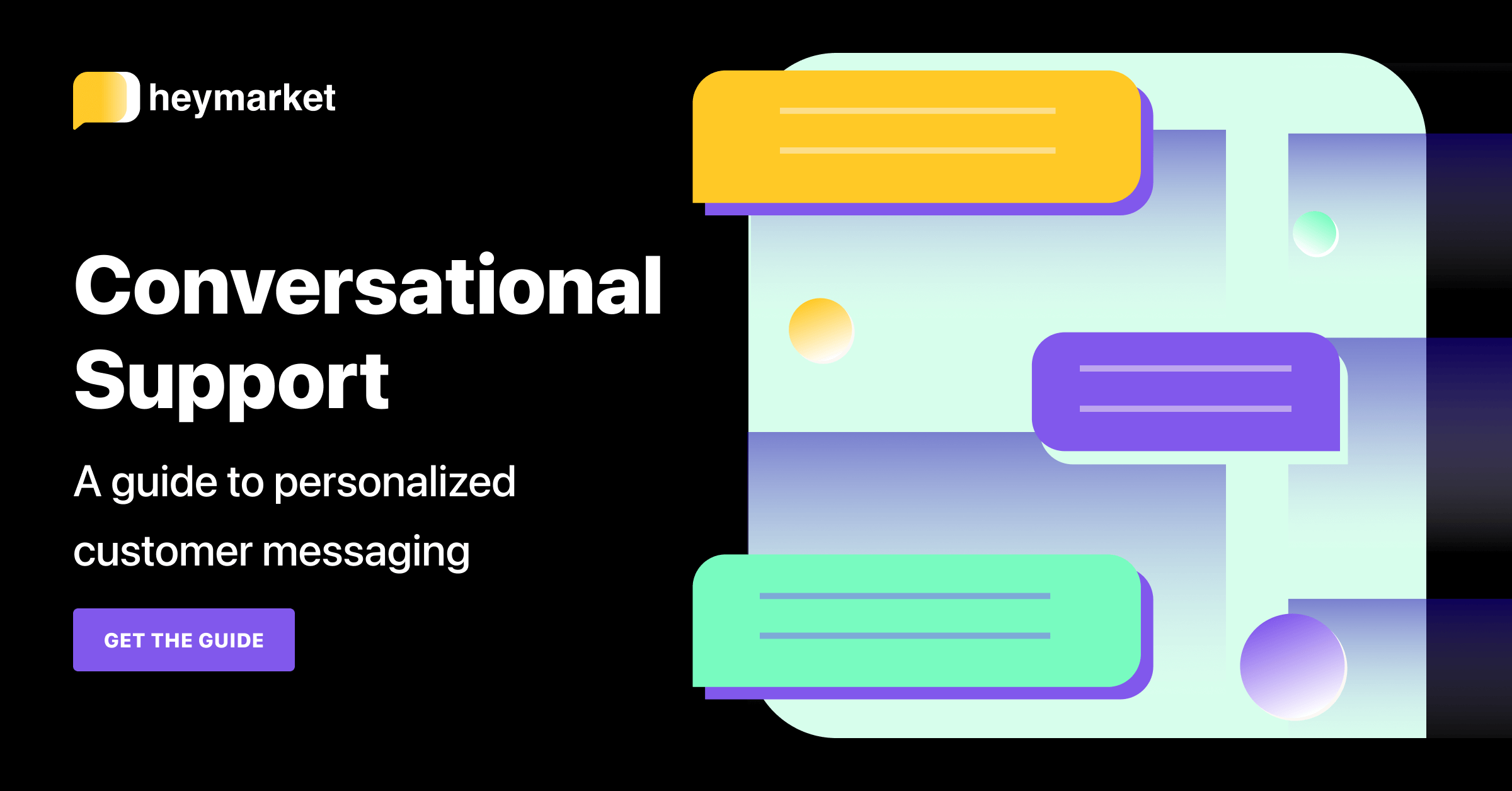Consumers’ expectations for customer service have hit an all-time high. 90% of customers expect a response to their questions within 10 minutes, and 66% expect you to understand their needs and meet their expectations for service. If you don’t, 89% of customers will leave your brand after just one poor experience. As a result, the customer experience is more important than ever.
As customer interactions continue to shift online in response to post-pandemic digital transformation, creating a personalized digital experience is crucial for businesses. It’s time for businesses to rethink their customer focus.
This article explores the ins and outs of customer focus, from what it is to what it looks like in action, and how your business can work toward becoming more customer-focused.
What Is Customer Focus?
Customer focus (or client focus, depending on your industry) is a business-wide strategy that involves building your operations, products, and services around customers. This strategy involves more than just personalization in customer service and marketing — you prioritize the customer experience above all else. It emphasizes the importance of having all-consuming knowledge of what your customers need and how your business can give it to them. The goal of a customer-focused business is customer success, which leads to business success in the form of better customer satisfaction, improved retention rates, and increased customer lifetime values.
In a 2005 Harvard Business Review article that established the meaning of customer focus, experts noted that businesses must “learn everything there is to learn about their customers at the most granular level, creating a comprehensive picture of each customer’s needs—past, present, and future.” Steadfast data-gathering is the foundation of this strategy.
Customer focus also involves building every aspect of your brand around these needs. Your teams must coordinate to share customer information, using it to guide product and service offerings, operations, and even your brand’s mission.

Why Is It Important to Be Customer-Focused?
Today’s customers expect businesses to be customer-focused—even if they aren’t using that term. Seventy-three percent of customers expect companies to understand their needs and expectations, while 62% expect companies to adapt based on their behaviors. However, only half of consumers believe companies actually understand their needs, and 47% think companies are adjusting based on their behaviors.
Becoming customer-focused will help your team meet these expectations. It will also help you:
- Build relationships. The more attuned you are to your customers’ backgrounds, interests, needs, and goals, the better you can connect with them. You can provide more useful products and services. You’re able to offer more engaging marketing content. You will also have more empathetic customer service messaging and email chats.
- Increase customer satisfaction. Customers are a lot more likely to feel satisfied if you’ve built strong relationships with them. A customer-focused business asks for frequent feedback—empowering your teams to proactively solve customer problems. Plus, customers will appreciate the value you put on their opinion and see that you’re always looking to improve.
- Retain more customers. The biggest factor in gaining customer loyalty is empathy. Understanding customers better—and catering to that knowledge—helps your customer service team connect with customers more easily, your marketing team creates resonant content, and your product team builds items or services that customers actually need to encourage returning customers.
- Grow your business. Businesses that demonstrate a deep knowledge of their customers (also called “customer intimacy”) achieve faster revenue growth than competitors. They’re able to leverage positive relationships and experiences to generate social proof with online reviews, personal recommendations, and other ambassador marketing. This combination comes as no surprise when you’ve built strong customer relationships, boosted their satisfaction, and kept them coming back for more by delighting them at every stage.
Customer focus brings undeniable benefits across teams—which makes sense for a strategy that touches every aspect of your business.
To learn more about creating customer-focused communications, read our Conversational Support Guide.
Understanding Customer Focus
Customer focus isn’t something you can just add to your business overnight. The journey to create a customer-focused business requires a lot of preparation, communication, and commitment to providing exceptional customer experiences.
Understanding customer focus means that you place the wants, needs, and feelings of your customers at the forefront of every aspect of your business. And to do so, you need to master these four elements of enabling comprehensive customer focus.

Step One: Understand customers’ wants, needs, and expectations
The only way you’re going to provide what customers want is by understanding what they want in the first place. You should know what customer needs and goals are, what is driving their decisions, and what they feel (in general and about your brand).
There are a few key ways to listen to and learn from your customers:
- Surveying customers. Your customers can tell you exactly what they want; you just need to ask them and give them an easy way to respond. Send surveys through the channels they use the most. Send them chat-based SMS surveys, messaging app surveys, email surveys, and social media surveys. (Facebook, Twitter, and Instagram offer built-in polling tools.)
- Customer service tickets, emails, and messages. Customer service and support communications can be telling. This is where you’ll find explicit complaints about your brand. Pay attention to trends you see in this sphere, and consider how they reveal what your customers actually want.
- Website and online reviews. Check your website’s reviews and third-party online review sites for comments about your brand. See what problems—or successes—they mention frequently. (Customer sentiment analysis can help you review these comments more efficiently and effectively.)
- Noting which products, services, or content customers prefer. Customers don’t have to say anything for your team to understand which of your products are most helpful. Use your website analytics to understand which items, services, or content are most popular. Depending on your business, you could source this information from your app analytics or online shop platform. Once you’ve uncovered what products and services customers are engaging with most, send surveys or reviews to determine why.
- Social listening. Over a third of consumers share their customer service experiences, whether they’re good or bad, on channels like Facebook and Instagram. Check the internet for direct mentions and hashtags around your brand. See what they’re saying about both your customer service and your products or services. (And take the opportunity to remedy complaints if you run into them.)
Compile all of your learnings to create a composite look at your customers.
Step 2: Build strong customer relationships
Relationships are the basis of your customer-focused service and support strategy. Doing business online is notoriously impersonal, so when it comes to communicating with your customers, you have an opportunity to do more than be a website or online storefront – you can humanize the experience.
Building strong relationships allows you to gain your customers’ trust. When you personalize messages and give customers attentive, individualized support, they’re more likely to have conversations than simply make transactions with you. This relationship allows you to more easily collect feedback and encourage loyal customers to become ambassadors for your brand, offering valuable social proof for your business.
There is a wide range of strategies for building strong customer relationships, but two incredibly important elements include conversational messaging and meeting customers in their preferred channels.
Conversational messaging is one-on-one messaging between your team members and customers, as opposed to one-way forms or automated response systems that prevent customers from having quality conversations with real people. It meets customers’ need for speed and personalization where they are: on their mobile phones.
Meeting customers where they are through conversational messaging makes it easier for customers to reach out. Plus, real-time conversations with team members help customers form closer connections with your brand.
Step 3: Deliver exceptional customer service
Customer focus requires your teams to provide customers with a seamless experience from start to finish. Today’s customers specifically prioritize fast answers and a personalized experience. Sixty-five percent of consumers are more likely to buy again from a retailer that remembers their name, what they bought before, and talking points from prior interactions.
From the very first point of contact with a customer, your customer-focused approach should prioritize resolution speed, personalized communication, and customer satisfaction. During this process, you can use tools like a business texting platform to auto-reply to inquiries for fast answers and custom fields to personalize each message based on the customer’s personal information.
Customer service must also enable seamless and accessible communication so that customers can get help when they need it. Offering customer service through multiple channels, especially in a business texting platform that combines channels into a dashboard for easy responses, provides more avenues for your service team to have valuable conversations with customers.
When you’re able to deliver effective, comprehensive, and personalized customer service, you’ll see an improvement in customer experiences that help build better relationships, satisfaction, and loyalty.
Step 4: Ensure each team stays up to date
The larger your company grows, the more distance your employees—particularly executive leaders—have between themselves and customers. Customer service agents chat with customers each and every day. C-level employees, high-level managers, and marketers? Not as much.
Set up regular touchpoints between these team members and customers to create a 360-degree customer view. For example, you might have a marketing manager take over a customer service messaging inbox for a day or have an operations team member answer support phone calls. They will get close contact with customers and learn a lot about them quickly.
In addition, return to that customer listening you did in step one. Don’t keep that valuable information in a silo. Share learnings about your customers in company newsletters, internal reports, town halls, and Slack channels. This can include hard data and even relevant customer emails and messages (personal information redacted, of course).
How to become a customer-focused business
Changing everything about your business requires great communication, an investment in your staff, and a full commitment to putting the customer first in all aspects of the business.
Customer focus is a highly effective strategy, but it can be hard to get started. Here are three essential elements of becoming customer-focused.
Leadership and employee buy-in
Transforming your business to revolve around your customers is a major change. You need every member of your business to buy into customer focus to be successful – from the very top to new hires.
As leaders, you need to consider how your business—from your products and services to operations to your mission—can better serve customers. Then, implement changes that make those strategies a reality, and don’t be afraid to make large adjustments. Share them with employees at all levels and change policies to accommodate them so that your business can make everything, from start to finish, connect with, serve, and benefit customers.
Remember to communicate company changes and the reasons behind them, too, so customers are aware of your dedication to meeting their needs.
Customer-centric hiring and training practices
Customer-focused businesses are highly personal and rely significantly on communication to provide exceptional customer service. Solving problems and creating a unique, enjoyable experience for your customers is an essential element of customer focus, so your team should be more than just great at their jobs – they must be great communicators as well.
In transitioning to a customer-focused business, you may also need to adjust your hiring practices. You can evaluate communication skills in addition to technical skills to ensure each member of your service team can empathize and communicate effectively with customers. This change may include mock interviews or calls to see how potential hires defuse negative situations, provide personalized service, and put the customer’s needs first.
You should also provide new and existing staff members with training during the transition and regularly afterward to help employ the new customer-focused strategies and procedures. Customer focus is a business-wide strategy that requires each member to commit to customer excellence. Employees also need resources and guidance to equip themselves with the necessary skills to provide exceptional support.
You can host conferences and training seminars to help practice new techniques and strategies, as well as have meetings where you review unique situations and problems that arise in your business and how to handle them. Individualized training can also help your higher-level staff build the skills necessary to instill a customer-focused mentality in their teams. And don’t forget to take feedback into account to refine your practices over time so that you’re always taking care of your customers.
Clear communication channels for customer feedback
Your business has its own unique challenges, customer base, and process that is unlike any other. So, there’s no one-size-fits-all solution or blueprint to becoming customer-focused. You need insight from your most valuable resource – customers.
Your communication channels should make it as easy as possible to get in touch with customers (and have them reach you) at scale. You can use a number of different channels, including Facebook Messenger, WhatsApp, Email, text messaging, and more, so that you can meet customers where they are and make your business accessible.
You’ll also want to encourage feedback from customers in addition to making yourself accessible for any issues that arise. Prompts like surveys or feedback requests via texting are a fast way to check in with customers and make it easy to receive feedback directly with the option to follow up for more information.
A business texting platform that enables multi-channel chats in a single dashboard and mass texting capabilities makes clear communication easy. Personalization with custom fields also helps to encourage responses and show customers that you care about their opinions.
Implementing customer focus in marketing and sales
When leads are choosing a product or company to do business with, they look for how you can help solve their problem. As a customer-focused business, you’re in a unique position because you know exactly what your customers want and need. This knowledge allows you to tailor your marketing and sales strategies to speak to those desires so that you can better engage and connect with potential customers.
Here’s how you can implement customer focus into marketing and sales strategies.
Creating customer personas and segments
Marketing and sales are complex processes that require you to use as much information as possible to build positive relationships, speak to leads’ needs, and provide a solution that they’re happy with. You can gain this information in a variety of ways, including focus groups, polls, surveys of existing customers, and through analytics from your CRM.
Creating customer personas helps you to build strategies that connect at scale. Using customer and sales information, as well as feedback from existing customers, you’re able to identify what kind of customers you’re reaching. You can also evaluate how your marketing and sales processes speak to each persona’s needs and make changes to ensure they’re being addressed.
Tailoring marketing messages to target customer needs
Every potential customer has a reason for making a purchase. After you’ve created personas and segments of customers to help evaluate and identify their needs, you can put them to use in your marketing.
Segmenting your leads is one way to ensure you’re sending relevant and valuable marketing messages. You can create lists based on the product or service they’re interested in, the channel they communicate through, or their purchase history and customer information (for existing customers). Then, you’ll identify their specific pain points – the problem they’re trying to solve – and build your marketing campaigns based on demonstrating how your business is the answer.
A business texting platform simplifies tailoring your marketing messages and segmenting lists. It’ll allow you to use information from your CRM to inform segmentation, add personalization through custom fields, create templates for mass texting, and make it easy to start two-way conversations from your messages.
Developing personalized sales approaches
Customer-focused sales strategies are all about understanding the needs of your lead and helping to solve their problem. Sales teams must have a deep understanding of the segments your business has, what they’re looking for, and be able to empathize with individuals through communication.
When developing a personalized sales approach, your goal should be establishing an effective procedure for taking different types of customers through the sales process. Depending on their persona or segment, you may provide different resources, offer specific accommodations, personalize communications, and make different offers. Sales teams must also tailor the stages of your sales funnel or process to fit individuals, not just segments, to provide a customer-focused, unique, and effective customer experience.
Customer focus in product development and innovation
When you employ a customer focus in your business, you work to know everything about your customers so that you can better serve them. The needs of these customers should drive every element of your business, including development and innovations.
Through research, feedback, and continued collaboration with customers, you can discover new products and services that address customers’ problems. Or, you can make changes to your existing business’s offerings to reflect the information you’ve gathered.
Here are a few ways customer focus guides your business’s future development and innovation.
Conducting market research to identify customer pain points
Your business helps to solve a problem for your customers. If you don’t know what their wants, needs, and pain points are, you can’t effectively address them. You’ll also struggle to empathize with customers and provide exceptional customer service.
Market research is a customer-focused approach to learning more about your customers. It comes in many forms, including focus groups composed of your personas or segments, text messaging surveys with opted-in leads or existing customers, and monitoring social media to collect public opinions relating to your business.
You can receive feedback on the problems your target audience is facing, customer service experiences, and many other aspects of your current business.
Involving customers in the product development process
Product development and innovation is an essential part of growing your business. With customer focus, it’s even more important because you’re trying to develop new products that customers want and need – not just to expand your catalog or chase your competitors. This effort to address every element of your customers’ problems is a staple of customer-focused business.
Customer feedback can help to guide you before, during, and after your development process. You may send out a poll to your customers asking if there’s something specific they’d like to see you offer. Focus groups may help you make informed decisions about the direction to take during development. You can offer loyal customers “sneak peeks” into new products in exchange for their feedback.
Continuous improvements based on customer feedback
You need to constantly be evaluating your products, services, procedures, communication, and services as a customer-focused business. Customer wants, and needs may change over time. It’s your job to continuously collect, review, and adjust to these changes so that you can continue to solve customers’ problems.
Customer feedback helps you make changes that positively impact your business. Reviews, surveys, and feedback requests about different products or services provide a lot of insight into what’s working. They’re easy to collect with a business texting platform.
Customer focus means taking this feedback into account and improving what you can improve for the best customer experience.
Measuring and analyzing customer focus
Customer focus emphasizes data collection in all forms. Direct feedback, reviews, surveys, and certain metrics about your service can give you insight into how you’re performing.
Consider these three elements of analyzing customer focus to ensure you’re providing the best experience possible to customers.
Key performance indicators for customer focus
Key performance indicators (KPIs) are an important element of evaluating your customer focus. Your goal is to provide a complete, unique, and excellent experience for your customers at all stages. Metrics provided by your CRM, sales, and support apps can give you a range of potential KPIs to consider.

Customer satisfaction score (CSAT) is the measure of how well you’re implementing customer focus in your business. Happy customers mean that you’re meeting their needs and meeting (or exceeding) the experience that they expect. You can collect stars, thumbs up, and number ratings from customers to give insight into multiple aspects of your service.
Resolution time is another metric that reflects your customer focus. Effective customer service is fast. Fast resolution times also mean that problems are being solved with little friction and by well-equipped support staff. Slow resolution times may mean staff needs additional resources or training.
Customer retention rates will indicate whether you’re providing the type of customer-focused experience that brings customers back. Information like whether customers who contact your customer service return to your business can indicate whether your communication is effective.
Customer satisfaction surveys and feedback mechanisms
Collecting customer feedback is essential for informing your customer focus. Customer satisfaction ratings give you a quick indicator of how you’re doing and are highly accessible to customers. They can come in many forms, including number ratings, yes/no answers, and direct replies. Surveys review requests are two common ways of collecting feedback.
Using SMS surveys with a business texting platform lets you schedule text messages to ask for feedback automatically after an order or when a ticket is closed. Direct replies will be collected alongside ratings which allow your customer service agents to gain additional insight by continuing the conversation.
Utilizing data analytics to track customer behavior
Tracking customer behavior helps you to learn more about your customers’ journeys. You can collect usage data that tells you where customers come from and where they go within your business at each step of the marketing, sales, and customer service processes.
KPIs like CSATs, web traffic sources, cart abandonment rates, and many more metrics help to inform your customer knowledge. This data also provides insights into which marketing strategies connect better, which channels your customers are found on, how well your customer service is performing, and whether you’re retaining customers.
Case studies: Successful customer focus implementation
Customer focus doesn’t just seem like a great idea on paper – it works.
Here are five customer-focused traits, with examples, to help you implement effective customer focus for your business.
Constantly asking for feedback – Torani

A business with a strong customer focus requests customer feedback often. Creating a constant feedback loop gives you a direct line to your customers’ needs and expectations of your business and whether you’re fulfilling them. This knowledge is the foundation of customer focus.
You might recognize Torani’s logo from your favorite cafe. The company creates syrups for flavoring all kinds of drinks, and after noticing that customers loved to rave about their products on social media, they implemented a business review program. They began using this tool to ask every customer for feedback and providing accessible methods of doing so, allowing customers to share their opinions and leading to a 167% year-over-year increase in reviews that they use to inform their business.
Regularly analyzing customer feedback and sentiment – Door-Mart

A business with a strong customer focus will set aside time to carefully comb through customer feedback, interactions, and online activities. From this data, they discern customers’ needs and goals and how the business’s current products, services, operations, and mission meet them.
Door-Mart provides installation and repair services for garage doors. They found that they were missing out on business because they weren’t answering customers fast enough, which was reflected in some negative online reviews. After hearing their customers’ feedback, Door-Mart instituted business text messaging that allows them to field all of their calls, texts, and emails in one place from their CRM. Now they can immediately address any calls they receive, which helped them reach 98% positive ratings and grow their business.
Forming a culture around the customer – Adorn Bridal

Companies with a strong focus on customers base their top-level business goals on their customers’ needs. Customers come first in all aspects of team members’ workdays, from scheduled meetings to business-wide culture initiatives.
Adorn Bridal is a bridal shop that focuses all elements of its business on providing a bespoke experience for each bride-to-be. They added business texting to their experience after the pandemic caused safety concerns and then a rush of business as it calmed down. They found that texting with brides made it much easier for them to share ideas and prepare for their shop visit, helping to improve the customer experience. Now, they’ve cut their in-person visit times in half and can keep track of all of a bride’s requests, style choices, sizing, and comments to make sure they’re addressing every need. Plus, they can check in closer to the ordering deadline with drip campaigns to nurture relationships and re-engage potential customers.
Building personalized customer experiences – Camp Gladiator

Customers want brands to remember them. Fifty-six percent of customers will shop with a store that recognizes them by name, while 65% are more likely to shop with a brand that knows their purchase history. Customer-focused businesses use channels that empower them to personalize interactions, like messaging services and email. These channels allow teams to sync with CRMs to access customer data, like names and order numbers.
Camp Gladiator’s owner started off sending texts to campers from his personal phone, limiting the amount of communication and personalization he was able to use for improving relationships. After adding business texting, the camp began sending more messages and using custom fields to personalize each message, amounting to an 18% increase in attendance and a 10% higher retention rate that grew the business – just from customizing texts and focusing on improving relationships.
Customer-focused digital transformation with ChatGPT and messaging

Creating frictionless, personalized customer experiences is a great start, but businesses with true customer focus also use the customer knowledge they’ve gathered to guide their business decisions. They make foundational changes based on customer needs, adapting as those needs change.
One internet service provider made a drastic change to their business by launching a digital transformation initiative that used ChatGPT, an emerging technology, to improve customer experiences. Based on customer feedback, they found that prospects preferred to communicate later at night outside of business hours, so answering their questions was taking longer than necessary. They then began implementing ChatGPT to provide AI-assisted replies to common questions. By connecting ChatGPT with Heymarket’s texting platform, they created a virtual text messaging assistant known as “Bria” that was able to text with customers using a script guide to deliver personalized responses automatically after-hours.
Challenges and best practices for maintaining customer focus
Customer focus can be intimidating to get started with. It’s a significant commitment to your customers that leads to business-wide changes. You also need to commit to being customer-focused over the long term to see these changes come to fruition and be open to adapting as you learn more about your customers.
Here are three challenges that may arise as you evolve into a customer-focused company.
Overcoming internal resistance to change
New customer-focused businesses go through a lot of changes. Policies, procedures, operations, communication, and many other elements of day-to-day business change quickly and often. Unsurprisingly, this disruption can lead to internal resistance from staff at all levels as expectations change.
One way to overcome resistance is to provide additional support, resources, and strategies to any customer-facing employees. Customer-focused communication and customer service take more time and effort, which is likely to be overwhelming without the appropriate support.
Dealing with customer complaints and resolving issues
Employing customer focus for your business means that you’ll be interacting with customers more than ever. You’ll receive plenty of feedback, both positive and negative, as you refine your strategies, offerings, and practices to best suit your customers. Fortunately, you can learn as much from a negative as a positive experience.
Unhappy customers are a part of business, but they don’t have to stay unhappy. Support teams must always go into each customer interaction with the goal of listening, empathizing, problem-solving, and ensuring satisfaction to the best of their ability. Then, collect, analyze, and evaluate the feedback to find where you need further improvement so that each interaction is a learning experience.
Sustaining a customer-focused mindset in the long term
Customer focus depends a lot on feedback and is always changing as your business learns more about your customers and collects new feedback. Changes happen regularly, so a customer-focused business can be hard to maintain over extended periods of time. However, it’s essential that you continue to adapt over time while you refine your strategies.
Creating a customer-focused culture throughout the entire business is one way to make customer focus easier to maintain. If every element of your business revolves around customers, it’s less likely to seem like an additional effort to delight customers at every stage.
If you need inspiration to sustain your customer-focused approach, review the positive feedback you’ve received to see how you’re helping improve customers’ lives. Or, check analytics and metrics on your customer service platform to visualize the improvements your efforts are yielding.
Customer Focus for Long-Term Business Success
As the world changes, your customers’ expectations will too. Delivering on their shifting needs for personalization and empathy will differentiate good companies from great ones. Adopting a customer focus mindset is the best way to stay up-to-date in an ever-changing market. Customer focus will:
- Keep your team updated on your customers’ goals and needs as they shift
- Help your teams form tight relationships with customers over time, promoting long-term loyalty
- Create a flexible environment that makes it easier to change business directions when necessary
Customer focus will help your business transform alongside customer needs, helping it stay relevant—and growing—well into the future.
Looking to learn more about becoming more customer-focused? Read our Conversational Support Guide.






